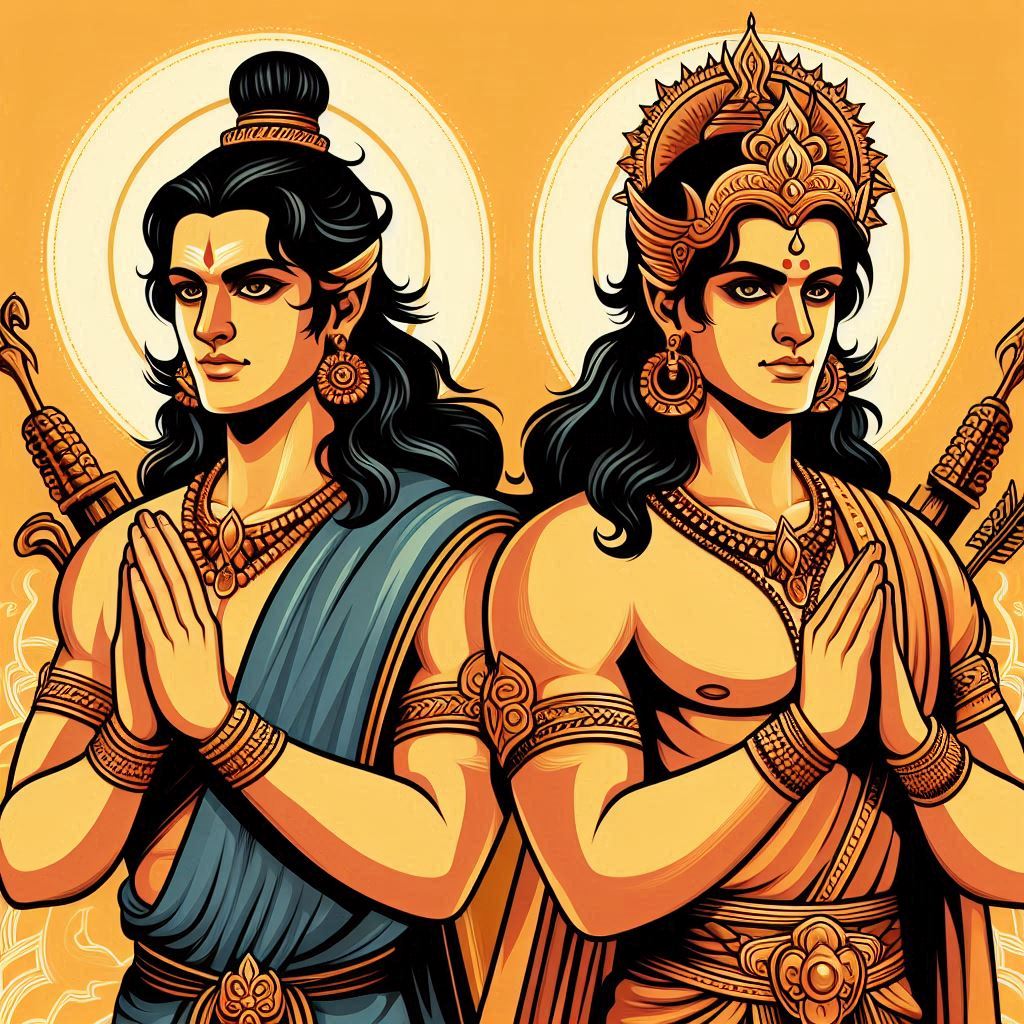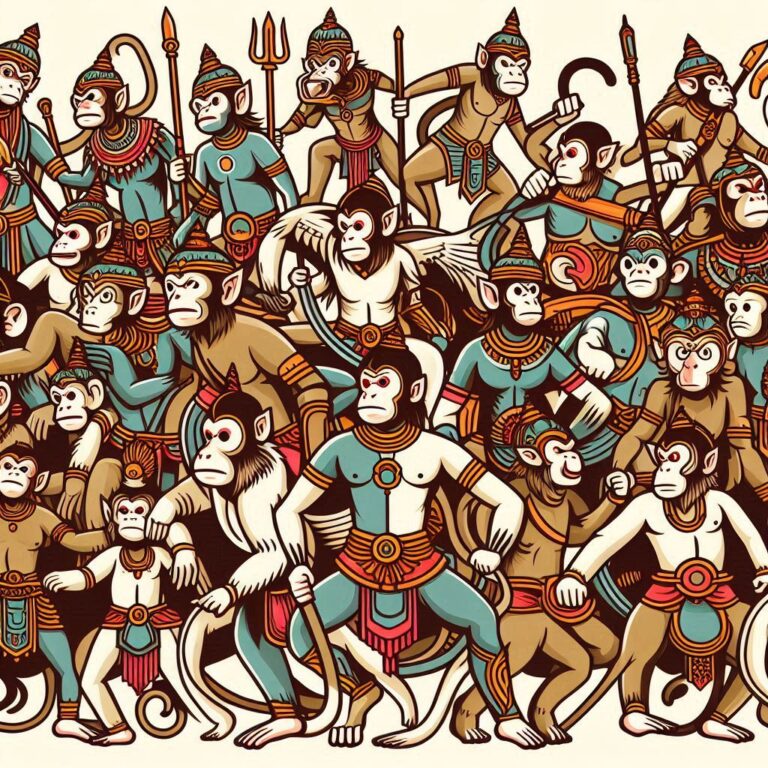The Bond Between Bharata and Shatrughna
Sibling relationships in Hindu epics have always fascinated readers, with each pairing presenting unique virtues and challenges. Among these, the bond between Bharata and Shatrughna stands out, defined by loyalty, duty, and unwavering support. While Rama and Lakshmana are often at the forefront of the Ramayan, Bharata and Shatrughna’s relationship offers equally powerful lessons in devotion and selflessness.
Background: Bharata and Shatrughna’s Birth
Bharata and Shatrughna, both sons of King Dasharatha of Ayodhya, were born to Queen Kaikeyi and Queen Sumitra, respectively. The birth of the four brothers—Rama, Lakshmana, Bharata, and Shatrughna—was foretold to have a divine purpose. Each was an incarnation of the Supreme Divine, tasked with protecting dharma and upholding righteousness in the world.
Shlokas that reflect their divine birth:
“रामो राजमणिः सदा विजयते रामं रमेशं भजे।
Rāmo rājamaṇiḥ sadā vijayate, rāmaṁ rameśaṁ bhaje
Translation: Rama, the jewel among kings, ever victorious, I bow to Rama, the Lord of Lakshmi.”**
This shloka hints at the divinity and higher purpose of the brothers, including Bharata and Shatrughna, who would play crucial roles in the larger narrative of the Ramayan.
The Special Relationship Between Bharata and Shatrughna
Unlike Lakshmana, who shared an intense bond with Rama, Shatrughna’s devotion lay with Bharata. Their connection was one of complementary personalities—while Bharata was known for his sense of justice and duty, Shatrughna was equally known for his quiet, unwavering loyalty.
As they grew, their brotherly love manifested in the way they supported one another. Bharata was seen as the leader, always righteous and mindful of dharma. Shatrughna, on the other hand, was the faithful companion, standing beside Bharata in every situation. Despite playing a more background role, Shatrughna’s quiet strength became one of the most admired aspects of his character.
Bharata’s Role in the Ramayan
Bharata’s role in the Ramayan is deeply intertwined with his loyalty to Rama. Upon discovering that his mother, Kaikeyi, had exiled Rama and secured the throne for him, Bharata was heartbroken. He refused to accept the kingship and instead, journeyed to the forest to bring his elder brother back.
Shloka describing Bharata’s devotion to Rama:
“न तात साम्राज्यमिदं न सुखानि वा। तव पादुकयोः सेवा मम राज्यं भविष्यति॥”
Na tāta sāmrājyamidaṁ na sukhāni vā | Tava pādukayoḥ sevā mama rājyaṁ bhaviṣyati ||
Translation: “Neither the empire nor comforts are dear to me, Father. Serving Rama’s sandals shall be my only rule.”**
This shloka beautifully captures Bharata’s commitment to his brother, refusing to enjoy the pleasures of kingship while Rama was in exile.
Shatrughna’s Role in the Ramayan
Shatrughna, often referred to as Bharata’s shadow, remained loyal to his elder brother throughout the narrative. Though he is not as prominent in battles or political decisions, Shatrughna played a key role in managing the kingdom alongside Bharata during Rama’s absence. His devotion to Bharata mirrored the same love and loyalty Lakshmana showed to Rama.
Shlokas on Shatrughna’s loyalty:
“शत्रुघ्नो नित्यसङ्ग्रहः भरतस्य प्रियो नृपः।
कृते भार्याभिवृद्धं स न याचित व्रजन्ति च॥”
Śatrughno nityasaṅgrahaḥ bharatasya priyo nṛpaḥ | Kṛte bhāryābhivṛddhaṁ sa na yācita vrajanti ca ||
Translation: “Shatrughna, ever loyal to Bharata, is a beloved prince, offering selfless support without seeking recognition.”**
This verse speaks to Shatrughna’s character—silent, yet steady, always present for Bharata.
Shatrughna’s Loyalty to Bharata
Shatrughna’s loyalty wasn’t merely a byproduct of family duty—it was an innate characteristic that defined him. He followed Bharata not out of obligation but from a genuine love for his elder brother. Even when Bharata refused the throne and chose to live in Nandigram, Shatrughna remained by his side, helping him manage the kingdom.

Their Bond During Rama’s Exile
Bharata’s refusal to accept the throne during Rama’s exile was a moment of great emotional upheaval. He placed Rama’s sandals on the throne as a symbol of his brother’s reign. During this challenging time, Shatrughna provided both emotional and practical support to Bharata. The two brothers shared the weight of ruling Ayodhya while longing for Rama’s return.
Shlokas Celebrating Their Bond
“भरतो धर्मधुरन्धरः, शत्रुघ्नः धर्मवत्सलः।
एतौ भ्रातरौ नित्यं रामे भक्तिरता स्तुतौ॥”
Bharato dharmadhurandharaḥ, Śatrughnaḥ dharmavatsalaḥ | Etau bhrātarau nityaṁ rāme bhaktiratā stutau ||
Translation: “Bharata, the bearer of dharma, and Shatrughna, the loving and loyal, both brothers are forever devoted to Rama.”**
Conclusion: The Legacy of Bharata and Shatrughna’s Bond
The bond between Bharata and Shatrughna exemplifies a relationship built on trust, loyalty, and a deep sense of duty. While often overshadowed by the more prominent bond of Rama and Lakshmana, their relationship offers equally significant lessons for anyone seeking to understand the values of family, service, and humility. Bharata’s unwavering commitment to dharma and Shatrughna’s quiet but powerful support serve as a beacon of how sibling bonds can transcend personal desires and ego, culminating in a higher purpose.
Their story continues to inspire generations, symbolizing that the strength of a family lies not in grand gestures but in quiet, constant companionship. Bharata and Shatrughna teach us that sometimes the most powerful form of love is silent support and shared responsibility.
Shlokas Celebrating Their Bond
“भरतो रामस्य वन्द्यो भ्राता धर्मेण संयुतः।
शत्रुघ्नः प्रियसखो नित्यं भ्रातृभक्त्या समन्वितः॥”
Bharato rāmasya vandyo bhrātā dharmeṇa saṁyutaḥ | Śatrughnaḥ priyasakho nityaṁ bhrātṛbhaktyā samanvitaḥ ||
Translation: “Bharata, a brother worthy of reverence for his righteousness, and Shatrughna, his loyal companion, are bound forever by their devotion to their brothers.”**
This shloka beautifully summarizes their relationship: Bharata, known for his steadfastness in upholding dharma, and Shatrughna, ever by his side, offering love and loyalty.
“तत्र भरतशत्रुघ्नौ धर्मे सत्पथवर्तिनौ।
निजं कर्तव्यं संरक्ष्य, रामभक्त्या समन्वितौ॥”
Tatra bharataśatrughnau dharme satpathavartinau | Nijaṁ kartavyaṁ saṁrakṣya, rāmabhaktyā samanvitau ||
Translation: “There stood Bharata and Shatrughna, both steadfast on the path of righteousness, fulfilling their duties with unwavering devotion to Rama.”**
This verse highlights how Bharata and Shatrughna both played essential roles in maintaining the balance of dharma during Rama’s absence, showing that true loyalty comes not just from affection but from living out one’s values.
FAQs
1. How did Bharata and Shatrughna’s relationship differ from that of Rama and Lakshmana?
While Rama and Lakshmana shared a deep bond rooted in mutual protection, Bharata and Shatrughna’s relationship was more about quiet support and shared responsibility. Shatrughna played a lesser-known but equally significant role in supporting Bharata during the most challenging times of his life.
2. Why did Shatrughna remain so loyal to Bharata?
Shatrughna’s loyalty stemmed from a deep sense of love and respect for Bharata. He understood Bharata’s immense burden and quietly took on responsibilities to help him rule Ayodhya during Rama’s exile. His loyalty was not just familial; it was a reflection of his character and devotion.
3. What lessons can modern-day families learn from Bharata and Shatrughna’s bond?
Bharata and Shatrughna teach us that familial relationships aren’t just about love but also about shared responsibilities, mutual respect, and selflessness. They show us that even in the background, quiet support can make a significant impact.
4. Why is Shatrughna’s role often overlooked in the Ramayan?
Shatrughna played a quieter role compared to his brothers. However, his contributions were invaluable, especially in supporting Bharata and later in his victories and governance. His character exemplifies silent strength and devotion.
5. What is the significance of Bharata’s refusal to take the throne?
Bharata’s refusal to ascend the throne was a testament to his deep love for Rama and his commitment to dharma. He felt it was not his place to rule while Rama, the rightful king, was in exile. This act of selflessness is one of the most powerful moments in the Ramayan, showcasing the ideals of duty and devotion.






